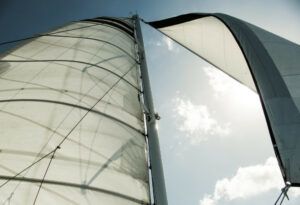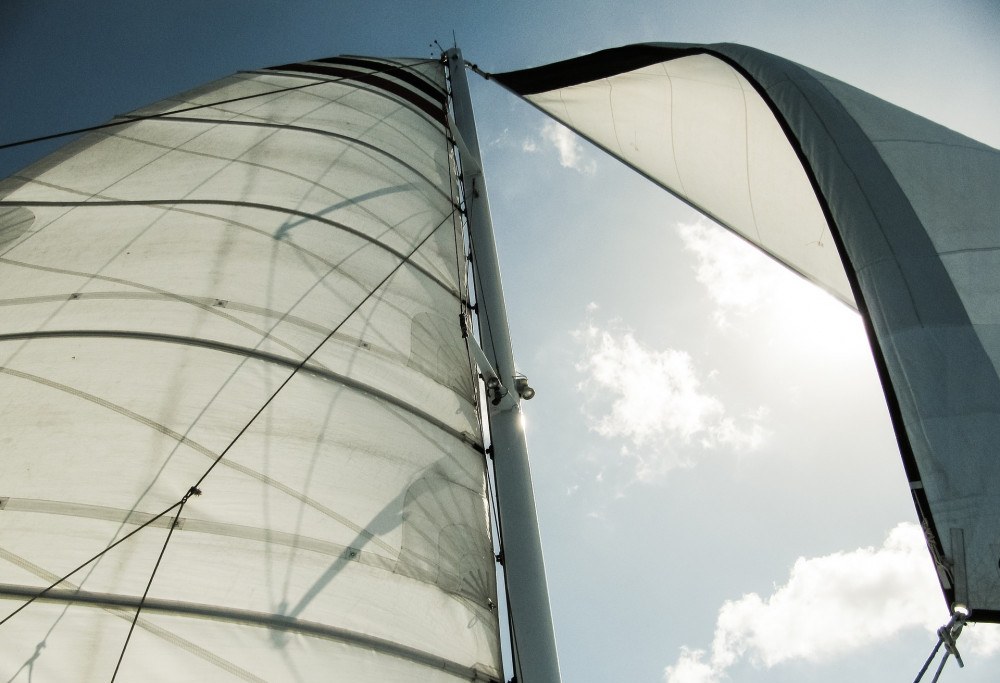This is aimed at the blue water cruising sailor that has his boat set up simply. He probably has just his mainsail and one all-purpose roller furling head sail. After a while cruising and getting more confident with his boat. He is ready to improve his boat’s sailing performance. Especially in lighter airs or downwind. Here are a few options that are available.
Cruising Sail Inventory
It is possible to have different sail combinations to match different conditions. Generally boats have the one mainsail with a few reef points so that we can alter the size to suit the wind. In the case of boats used for day sailing or racing, there are different sized head sails that can be used to match the wind conditions on the day. Some boats can have 2, 3 or maybe even more head sails on board at any given time.
For the cruising sailor, where space on board is at a premium, often times this is not practical. A compromise is reached. Instead of having a big, light #1 Genoa, a medium #2 Genoa and a heavy #3 Jib on board for different wind conditions. The cruising sailor will normally have just the one roller furling head sail. Most times this is a medium-sized, all-purpose #2 Genoa rigged on a furler so that it can be reefed easily. Sometimes, the prudent sailor will also have storm-sails and maybe a spare sail or two for emergencies if there is space.

How the Boat Sails
Now the cruising sailor has an easy sail plan to work with. He can reef both sails to suit increasing winds and is maximizing his available storage space. The boat is set up for sailing in medium to heavy breeze upwind or on a reach. However, the boat suffers in light wind on all points of sail. And downwind it could do with more sail area as well.
Many sailors are OK with this and think nothing of the longer passages. They accept this compromise and never give it another thought. In light air they will use the engine and are happy to go downwind with the sail plan they have. Others are not so easy going. They want to improve and maximize their boat’s performance. Here are some ways to fill out the sail plan.
Downwind
The sail that comes to mind when thinking about downwind is the spinnaker. Many cruisers are gun shy when it comes to the spinnaker. Thinking about broaches, symmetrical spinnakers, spinnaker poles and all the assorted lines and hands needed. Who can blame them? With the advent of asymmetrical spinnakers and smaller cruising Gennakers, the ease of handling is greatly simplified. They normally come with a snuffer and with a little practice can be easy to use.
However, they are powerful sails and can still be a handful. Especially if you leave snuffing it until it’s too windy. It also requires someone to go onto the fore deck to deal with it. This is what turns many short-handed cruisers off spinnakers. There are now Top Down furlers that enable you to furl up the spinnaker, similar to how you would furl your head sail. The advantage here is that you can rig it to be operated from the relative safety of the cockpit.
Another option that is popular with cruisers is a second head sail. This can be used wing on wing together with your permanently rigged roller furler Genoa to go down wind. Although this is not as powerful as a spinnaker it is much easier to operate from the cockpit even in a heavier wind. It uses a normal bottom up furler with a torsion rope sewn into the Luff of the sail. This can be hoisted and then the sail furled and unfurled as needed. It can also be taken down and stored away when not in use.
Light Air Performance
In order to improve the light air sailing ability of your boat you would need a bigger and lighter head sail. Now we can use a Genoa with torsion rope and bottom up furling system as described above. This can serve the dual-purpose of extra sail area downwind as well as for a light air head sail, even going upwind.
For many cruisers this is a great option as many of them have light air #1 Genoas lying around. They may have taken them off the boat to make space for cruising. But now they can be modified to fill out the sail plan. All that is needed is the torsion rope and furling system.
Compared to a spinnaker option, this is much more economical. Especially if you already have a sail. If not, you can have a light air Dacron sail purpose made for about the same price as a spinnaker.
Conclusion
Everything in sailing is compromise. In lighter winds the spinnaker is better downwind. But the double head sail rig is easier to handle in heavier wind. You can also use the double head sail rig in stronger winds long after you would have had to douse the spinnaker. For pure speed increase and thrill of sailing then the spinnaker is the choice. But for ease of mind, handling and comfort, then the double head sail rig is better.
Each sailor has their own opinions and skill levels so everyone will make different choices. Hope this information was helpful. Please feel free to contact if any questions or if you need some more information.
Bear in mind that some links on this website are affiliate links. If you go through them to make a purchase we will earn a commission at no extra cost to you but helps support our website. Keep in mind that we link these companies and their products because of their quality and not because of the commission we receive from your purchases.

